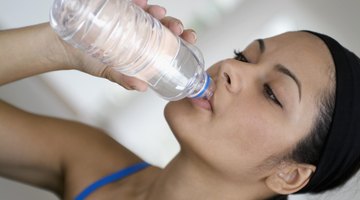How to Remove Adhesive Residue from Plastic
While plastic serves as an economical and versatile material, lending itself to everything from DVDs to kitchen containers, the sticky gunk that lingers after you've peeled an adhesive label off your new plastic product is a recurring annoyance in modern life.

Whether you want to remove the remnants of stubborn price tag before giving that new video game as a gift or a strong bit of tape has left some residue on your trusty storage bin, you can turn to common household items to cut through the crud.
Things You Will Need
- Dull knife
- Paper towels
- Liquid dishwashing detergent
- Vinegar or ammonia
- Sponge
- Clean, soft cloths
- Household penetrating oil lubricant
Tip
Read and follow any care instructions provided by the manufacturer of your plastic products. Likewise, heed any instructions or warnings provided by the manufacturer of any commercial cleaning products you use. Test your cleaning cloth or sponge and your solvent on a small, inconspicuous portion of the plastic product to ensure that your cleaning methods won't harm the plastic's surface. Window cleaner, acetone and hair shampoo serve as alternative solvents in place of a dish detergent solution, while petroleum jelly can be used as a lubricant. To prevent scratches, avoid using abrasive cleaners or abrasive cleaning cloths on plastic.
Warning
Power down and unplug any electric-powered plastic items before cleaning them.
-
Rub the adhesive residue with your thumb, using short strokes to roll the residue into small pieces. This helps remove adhesive residue from stickers with pressure-sensitive adhesive, which has a texture similar to rubber cement. If this doesn't work, you're likely dealing with adhesive left over from water-soluble glue.
-
Saturate a few paper towels in clean, warm water, folding the towels into layers. Place the dampened paper towels over the adhesive residue and let the plastic rest for a few minutes. This helps loosen water-soluble adhesive, making it easier to remove.
-
Scrape the remaining residue gently with your fingernail or a dull knife. Test a small area of the plastic first to make sure you don't leave unsightly scratches on the plastic's surface.
-
Dampen a sponge or soft cloth in a solution of warm water, liquid dish-washing detergent and vinegar or ammonia. Rub the leftover adhesive with a circular motion, applying moderate pressure. Wipe the surface with a cloth or sponge dampened with plain water, then dry the plastic with a clean, dry cloth and repeat as necessary.
-
Treat the adhesive with a household penetrating-oil lubricant if stubborn gunk remains, spraying the spot and rubbing residue away with a cloth. After treating the plastic with adhesive, clean the oil from its surface with soapy water. If you don't have lubricant, salad oil or mineral oil does the trick.
The Drip Cap
- While plastic serves as an economical and versatile material, lending itself to everything from DVDs to kitchen containers, the sticky gunk that lingers after you've peeled an adhesive label off your new plastic product is a recurring annoyance in modern life.
- Rub the adhesive residue with your thumb, using short strokes to roll the residue into small pieces.
- Saturate a few paper towels in clean, warm water, folding the towels into layers.
References
Resources
Writer Bio
Dan combines his decade-long experience as a freelance writer with hands-on experience in landscaping, flooring, painting, maritime maintenance and handy man work. Previously, he's published with Black+Decker, Geeks On Home, GardenGuides.com, GOBankingRates.com, USA Today, SFGate Home and others.
Photo Credits
- Medioimages/Photodisc/Photodisc/Getty Images
- Medioimages/Photodisc/Photodisc/Getty Images
More Articles



